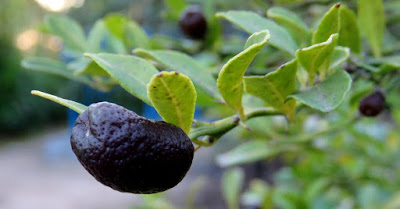Bloody Australian citrus
This clotted-blood-like fruit is an Australian bred citrus growing in our Australian Garden at Cranbourne Gardens. It's an example of the dozens of new citrus cultivars available now with at least one of their parents a local species (you might have caught Angus Stewart singing their praises on the 25 June episode of Gardening Australia).
When I last posted on citrus I was announcing that a large number of Citrus species are native to our part of the world. That part is Papua New Guinea, New Caledonia and Australia, where you'll find half of the world's 25 species of Citrus. One of those local species is the appropriately named Citrus australasica (the Finger Lime), a parent of this black dimply fruit.
We call it Australian Blood but it's also known as Australian Blood Lime, Australian Red Centre Lime, Australian Red Lime or simply Red Lime. A hybrid between Citrus australasica var. sanguinea ('sanguine' means blood red, a red fruited variant of the Finger Lime) and Citrus x limonia (the Ranpur Lime, a cross between a mandarin and a lemon), it produces a small but striking fruit in late autumn (when I took these photographs).
According to one of its growers, the plant was selected by CSIRO at Merbein in 1990. Like many citrus, the skin colour of the fruit is variable depending on growing conditions and maturity. In this case it can be gold with red markings or fully blood red. The ones I photographed were a little more like congealed blood, or at best a dried burgundy-blood colour. Inside the flesh can be lime-coloured (as these were), or partly or fully red.
It tastes like a lime, with that appealing popping sensation as you crush the 'vescicles' of juice, as in a Finger Lime. Also like the Finger Lime, the bush is a little spiny.
Australian Sunrise is another cultivar we grow in the Australian Garden, and it too has the Finger Lime as a parent, this time the non-red variety. The fruit and plant look very like the Australian Blood and that's because the other partner is the Calamondin which, as I mentioned in my previous post, is a hybrid between a mandarin and a cumquat (not miles away from the Ranpur Lime).
In older literature you might see the Australian citrus classified in genera such as Eremocitrus and Microcitrus but these days we include all the citrus-like species in Citrus (although there are still a couple of more distant citrus relatives put in other genera).The Australian Plant Census lists nine species and five formally named hybrids from Australia, including of course Citrus australasica, the common element in the two cultivars I've featured today.
The first Director of Royal Botanic Gardens Victoria (when it was named otherwise), Ferdinand von Mueller, described this species in 1858 from a collection made at Moreton Bay in Queensland. The natural distribution of this species is clustered around Moreton Bay, and Brisbane, where it grows in wet and dry rainforest near the New South Wales/Queensland border. The variety sanguinea was described by Queensland Colonial Botanist, Frederick M. Bailey, in 1892, from Tambourine Mountain. I don't know if it occurs in naturally in any other locations.
Australian species tend to be more drought, salinity and disease tolerant that other species of Citrus and they hybridise relatively freely with many other species and hybrid-species. This makes them ideal candidates as rootstocks, and for grafting onto other successful rootstocks. Those selections with unusual fruit colours, shapes and flesh textures - such as many of the Finger Lime crosses - are becoming ever popular with a market forever it seems in search of something new to eat.
Australian species tend to be more drought, salinity and disease tolerant that other species of Citrus and they hybridise relatively freely with many other species and hybrid-species. This makes them ideal candidates as rootstocks, and for grafting onto other successful rootstocks. Those selections with unusual fruit colours, shapes and flesh textures - such as many of the Finger Lime crosses - are becoming ever popular with a market forever it seems in search of something new to eat.





Comments
My experience with both these species is that while they grow and fruit well on the Mornington Peninsula they grow very little when the weather is cooler. I have espaliered my finger lime so I can harvest them without injury from the spines and have learned not to train the plant until the weather has warmed during the Spring. @Tim does this match with your experience?